A) I
B) II
C) III
D) IV
E) Both I & II
Correct Answer

verified
Correct Answer
verified
Essay
Provide the structure for (4R,8S)-4-iodo-2,2,8-trimethyldecane.
Correct Answer

verified
Correct Answer
verified
Multiple Choice
Which of the following is the rate equation for the following SN2 reaction? ![Which of the following is the rate equation for the following S<sub>N</sub>2 reaction? A) Rate = k[1-bromopropane] B) Rate = k[NaCN] C) Rate = k[1-bromopropane] [NaCN] D) Rate = k[1-bromopropane]<sup>2</sup> E) Rate = k[1-bromopropane]<sup>2 </sup>[NaCN]<sup>2</sup>](https://d2lvgg3v3hfg70.cloudfront.net/TB3185/11eab459_a6be_2690_acdb_7b665fe207e2_TB3185_00.jpg)
A) Rate = k[1-bromopropane]
B) Rate = k[NaCN]
C) Rate = k[1-bromopropane] [NaCN]
D) Rate = k[1-bromopropane]2
E) Rate = k[1-bromopropane]2 [NaCN]2
Correct Answer

verified
Correct Answer
verified
Multiple Choice
What is the IUPAC name for the following compound? 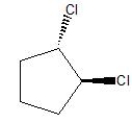
A) 1,2-bromocyclopentane
B) (1R, 2S) -1,2-dibromocyclopentane
C) (1S, 2S) -1,2-dibromocyclopentane
D) (1S, 2R) -1,2-dibromocyclopentane
E) (1R, 2R) -1,2-dibromocyclopentane
Correct Answer

verified
Correct Answer
verified
Essay
Predict the product for the following reaction. 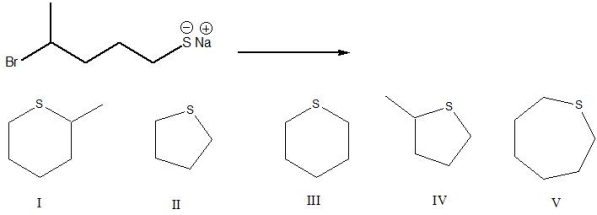 A) I
B) II
C) III
D) IV
E) None of these
A) I
B) II
C) III
D) IV
E) None of these
Correct Answer

verified
Correct Answer
verified
Essay
What is the IUPAC name for the following compound? 
Correct Answer

verified
(1R, 3S)-3...View Answer
Show Answer
Correct Answer
verified
View Answer
Essay
For the following reaction, label the nucleophile, electrophile, and leaving group. 
Correct Answer

verified
Correct Answer
verified
Multiple Choice
What is the nucleophile in the following reaction? 
A) I
B) II
C) III
D) IV
Correct Answer

verified
Correct Answer
verified
Essay
For the following reaction, label the nucleophile, electrophile, and leaving group. 
Correct Answer

verified
Correct Answer
verified
Multiple Choice
What is the classification for the following halide? 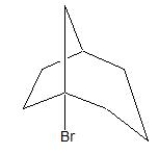
A) primary halide
B) secondary halide
C) tertiary halide
D) quaternary halide
Correct Answer

verified
Correct Answer
verified
Multiple Choice
What substitution reaction mechanism is most likely for the following compound? 
A) SN1
B) SN2
C) Either SN1 or SN2
D) None of these
Correct Answer

verified
Correct Answer
verified
Multiple Choice
Which of the following is a substitution reaction? 
A) I
B) II
C) III
D) IV
Correct Answer

verified
Correct Answer
verified
Multiple Choice
What is the IUPAC name for the following compound? 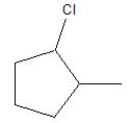
A) Chlorocyclopentane
B) 2-Chloro-1-methylcyclopentane
C) 1-Methyl-2-chlorocyclopentane
D) 1-Chloro-2-methylcyclopentane
Correct Answer

verified
Correct Answer
verified
Essay
Which of the following compounds will undergo the fastest SN1 reaction? Explain your choice. 
Correct Answer

verified
Compound IV The carb...View Answer
Show Answer
Correct Answer
verified
View Answer
Multiple Choice
What substitution reaction mechanism is most likely for the following conversion? 
A) SN1
B) SN2
C) Either SN1 or SN2
D) None of these
Correct Answer

verified
Correct Answer
verified
Multiple Choice
Which of the following is not a possible step in a substitution reaction? 
A) I
B) II
C) III
D) IV
Correct Answer

verified
Correct Answer
verified
Multiple Choice
Which of the following is a tertiary alkyl halide?
A) (CH3) 2CHCH2Cl
B) (CH3) 2CClCH2CH3
C) (CH3) 2CHCHClCH3
D) (CH3) 2CHCH2CHClCH2CH3
Correct Answer

verified
Correct Answer
verified
Multiple Choice
What substitution reaction mechanism is most likely for the following compound? 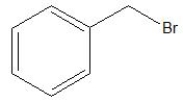
A) SN1
B) SN2
C) Either SN1 or SN2
D) None of these
Correct Answer

verified
Correct Answer
verified
Multiple Choice
Consider the following SN2 reaction,  Assuming no other changes, what is the effect on the rate, if the concentration of 1-chloro-3-methylbutane is doubled?
Assuming no other changes, what is the effect on the rate, if the concentration of 1-chloro-3-methylbutane is doubled?
A) No effect
B) It would double the rate
C) It would triple the rate
D) It would increase four times
E) It would reduce by half
Correct Answer

verified
Correct Answer
verified
Multiple Choice
What is the nucleophile in the following reaction? 
A) I
B) II
C) III
D) IV
Correct Answer

verified
Correct Answer
verified
Showing 81 - 100 of 123
Related Exams